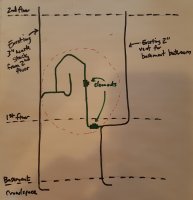I'm about to start a laundry room remodel on my house's first floor and would like to move the washer and dryer. The location the washer would be moved to is on a wall that has a 3" waste stack servicing one (and only one) bathroom ( with a tub, toilet and sink) on the second floor above the laundry room. The trap arm for the new washer standpipe would be about 4-6" inches to the existing waste stack (so it's close to the minimum trap arm length).
My question is: Am I allowed to use the 3" waste stack as a wet vent for the new washer standpipe so I can avoid putting in a new dry vent? I don't have a good way to run a dry vent up to the roof from the new washer location. I think/hope the answer is yes because the trap arm isn't long enough to require a dry vent and the waste stack is large enough to not cause siphoning, but I confess I don't know the finer points of wet venting, such as same floor/different floor limitations, etc.
Thanks in advance for any advice y'all can give!
Chris
My question is: Am I allowed to use the 3" waste stack as a wet vent for the new washer standpipe so I can avoid putting in a new dry vent? I don't have a good way to run a dry vent up to the roof from the new washer location. I think/hope the answer is yes because the trap arm isn't long enough to require a dry vent and the waste stack is large enough to not cause siphoning, but I confess I don't know the finer points of wet venting, such as same floor/different floor limitations, etc.
Thanks in advance for any advice y'all can give!
Chris

